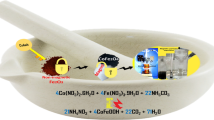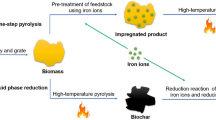Abstract
The adsorption behavior of mesoporous iron nanocomposites was investigated with respect to chromate [Cr(VI)] removal from aqueous solutions to consider its application for purifying chromate-contaminated wastewaters. These nanocomposites were prepared by borohydride reduction in aqueous solutions containing varying concentrations of acetone as co-solvent. Using batch methods, enhanced adsorption of Cr(VI) on the nanocomposite surface was achieved at neutral pH conditions, which subsequently resulted in Cr(VI) reduction to Cr(III). The Langmuir model was found to excellently describe the adsorption process, offering a maximum adsorptive capacity of 34.1 mg/g for composites prepared with 50 % acetone concentration. The Cr(VI) removal efficiency of these iron nanocomposites is strongly dependent on the acetone concentration, as evident from their (1) increased surface area (141.1 m2/g) compared to conventional iron nanoparticles (33.2 m2/g), and (2) highly porous and acicular structure, which efficiently traps Cr(VI) through adsorption. X-ray photoelectron spectroscopy analysis of Cr(III) on the nanocomposite surface confirmed that Cr(VI) removal from solution was achieved by sequential adsorption–reduction.








Similar content being viewed by others
References
Alowitz MJ, Scherer MM (2002) Kinetics of nitrate, nitrite, and Cr(VI) reduction by iron metal. Environ Sci Technol 36:299–306
Bokare AD, Choi W (2010) Chromate-induced activation of hydrogen peroxide for oxidative degradation of aqueous organic pollutants. Environ Sci Technol 44:7232–7237
Bond DL, Fendorf S (2003) Kinetics and structural constraints of chromate reduction by green rusts. Environ Sci Technol 37:2750–2757
Bonder MJ, Zhang Y, Kiick KL, Papaefthymiou V, Hadjipanayis GC (2007) Controlling synthesis of Fe nanoparticles with polyethylene glycol. J Magn Magn Mater 311:658–664
Carpenter EE (2001) Iron nanoparticles as potential magnetic carriers. J Magn Magn Mater 225:17–20
Chang LY (2005) Chromate reduction in wastewater at different pH levels using thin iron wires—a laboratory study. Environ Prog 24:305–316
Chen SS, Cheng CY, Li CW, Chai PH, Chang YM (2007) Reduction of chromate from electroplating wastewater from pH 1 to 2 using fluidized zero valent iron process. J Hazard Mater 142:362–367
Chiron N, Guilet R, Deydier E (2003) Adsorption of Cu(II) and Pb(II) onto a grafted silica: isotherms and kinetic models. Water Res 37:3079–3086
Eisazadeh H (2007) Removal of chromium from waste water using polyaniline. J Appl Polym Sci 104:1964–1967
Fendorf SE, Li G (1996) Kinetics of chromate reduction by ferrous iron. Environ Sci Technol 30:1614–1617
Flury B, Frommer J, Eggenberger U, Mäder U, Nachtegaal M, Kretzschmar R (2009) Assessment of long-term performance and chromate reduction mechanisms in a field scale permeable reactive barrier. Environ Sci Technol 43:6786–6792
Gillham RW, Ohannesin SF (1994) Enhanced degradation of halogenated aliphatics by zero valent iron. Ground Water 32:958–967
Glavee GN, Klabunde KJ, Sorensen CM, Hadjipanayis GC (1995) Chemistry of borohydride reduction of iron(II) and iron(III) ions in aqueous and nonaqueous media. Formation of nanoscale Fe, FeB, and Fe2B powders. Inorg Chem 34:28–35
Gupta S, Babu BV (2009) Utilization of waste product (tamarind seeds) for the removal of Cr(VI) from aqueous solutions: equilibrium, kinetics, and regeneration studies. J Environ Manage 90:3013–3022
Jeen SW, Blowes DW, Gillham RW (2008) Performance evaluation of granular iron for removing hexavalent chromium under different geochemical conditions. J Contam Hydrol 95:76–91
Jiang Z, Lv L, Zhang W, Du Q, Pan B, Yang L, Zhang Q (2011) Nitrate reduction using nanosized zero-valent iron supported by polystyrene resins: role of surface functional groups. Water Res 45:2191–2198
Kanel SR, Choi H (2007) Transport characteristics of surface-modified nanoscale zero-valent iron in porous media. Water Sci Technol 55:157–162
Kayser MM, Eliev S, Eisenstein O (1982) Reduction of ketones by sodium borohydride in the absence of protic solvents. Inter versus intramolecular mechanism. Tetrahedron Lett 24:1015–1018
Kendelewicz T, Liu P, Doyle CS, Brown GE Jr (2000) Spectroscopic study of the reaction of aqueous Cr(VI) with Fe3O4(111) surfaces. Surf Sci 469:144–163
Kim JH, Tratnyek PG, Chang YS (2008) Rapid dechlorination of polychlorinated dibenzo-p-dioxins by bimetallic and nanosized zerovalent iron. Environ Sci Technol 42:4106–4112
Kowalski Z (1994) Treatment of chromic tannery wastes. J Hazard Mater 37:137–141
Lee JM, Kim JH, Lee JW, Kim JH, Lee HS, Chang YS, Nurmi JT, Tratnyek PG (2008) Synthesis of Fe-nano particles obtained by borohydride reduction with solvent. In: International conference on remediation of chlorinated and recalcitrant compounds
Legrand L, El Figuigui A, Mercier F, Chausse A (2004) Reduction of aqueous chromate by Fe(II)/Fe(III) carbonate green rust: kinetic and mechanistic studies. Environ Sci Technol 38:4587–4595
Li XQ, Cao J, Zhang WX (2008) Stoichiometry of Cr(VI) immobilization using nanoscale zero valent iron (nZVI): a study with high-resolution X-ray photoelectron spectroscopy (HR-XPS). Ind Eng Chem Res 47:2131–2139
Liu Y, Majetich SA, Tilton RD, Sholl DS, Lowry GV (2005) TCE dechlorination rates, pathways, and efficiency of nanoscale iron particles with different properties. Environ Sci Technol 39:1338–1345
Liu Y, Phenrat T, Lowry GV (2007) Effect of TCE concentration and dissolved groundwater solutes on NZVI-promoted TCE dechlorination and H2 evolution. Environ Sci Technol 41:7881–7887
Loyaux-Lawniczak S, Refait P, Ehrhardt JJ, Lecomte P, Génin JMR (2000) Trapping of Cr by formation of ferrihydrite during the reduction of chromate ions by Fe(II)–Fe(III) hydroxysalt green rusts. Environ Sci Technol 34:438–443
Ludwig RD, Su C, Lee TR, Wilkin RT, Acree SD, Ross RR, Keeley A (2007) In situ chemical reduction of Cr(VI) in groundwater using a combination of ferrous sulfate and sodium dithionite: a field investigation. Environ Sci Technol 41:5299–5305
Lv X, Xu J, Jiang G, Xu X (2011) Removal of chromium(VI) from wastewater by nanoscale zero-valent iron particles supported on multiwalled carbon nanotubes. Chemosphere 85:1204–1209
Margeat O, Dumestre F, Amiens C, Chaudret B, Lecante P, Respaud M (2005) Synthesis of iron nanoparticles: size effects, shape control and organisation. Prog Solid State Chem 33:71–79
Matheson LJ, Tratnyek PG (1994) Reductive dehalogenation of chlorinated methanes by iron metal. Environ Sci Technol 28:2045–2053
Park SJ, Jang YS (2002) Pore structure and surface properties of chemically modified activated carbons for adsorption mechanism and rate of Cr(VI). J Colloid Interface Sci 249:458–463
Periasamy M, Thirumalaikumar M (2000) Methods of enhancement of reactivity and selectivity of sodium borohydride for applications in organic synthesis. J Organomet Chem 609:137–151
Pettine M, D’Ottone L, Campanella L, Millero FJ, Passino R (1998) The reduction of chromium (VI) by iron (II) in aqueous solutions. Geochim Cosmochim Acta 62:1509–1519
Phenrat T, Saleh N, Sirk K, Tilton RD, Lowry GV (2007) Aggregation and sedimentation of aqueous nanoscale zerovalent iron dispersions. Environ Sci Technol 41:284–290
Pike J, Hanson J, Zhang L, Chan SW (2007) Synthesis and redox behavior of nanocrystalline Hausmannite (Mn3O4). Chem Mater 19:5609–5616
Pillay K, Cukrowska EM, Coville NJ (2009) Multi-walled carbon nanotubes as adsorbents for the removal of parts per billion levels of hexavalent chromium from aqueous solution. J Hazard Mater 166:1067–1075
Ponder SM, Darab JG, Mallouk TE (2000) Remediation of Cr(VI) and Pb(II) aqueous solutions using supported, nanoscale zero-valent iron. Environ Sci Technol 34:2564–2569
Pratt AR, Blowes DW, Ptacek CJ (1997) Products of chromate reduction on proposed subsurface remediation material. Environ Sci Technol 31:2492–2498
Saleh N, Phenrat T, Sirk K, Dufour B, Ok J, Sarbu T, Matyjaszewski K, Tilton RD, Lowry GV (2005) Adsorbed triblock copolymers deliver reactive iron nanoparticles to the oil/water interface. Nano Lett 5:2489–2494
Saleh N, Kim HJ, Phenrat T, Matyjaszewski K, Tilton RD, Lowry GV (2008) Ionic strength and composition affect the mobility of surface-modified fe0 < nanoparticles in water-saturated sand columns. Environ Sci Technol 42:3349–3355
Schrick B, Hydutsky BW, Blough JL, Mallouk TE (2004) Delivery vehicles for zerovalent metal nanoparticles in soil and groundwater. Chem Mater 16:2187–2193
Sedlak DL, Chan PG (1997) Reduction of hexavalent chromium by ferrous iron. Geochim Cosmochim Acta 61:2185–2192
Shen YF, Zerger RP, DeGuzman RN, Suib SL, McCurdy L, Potter DI, O’Young CL (1993) Manganese oxide octahedral molecular sieves: preparation, characterization, and applications. Science 260:511–515
Shi LN, Zhang X, Chen ZL (2011) Removal of chromium(VI) from wastewater using bentonite-supported nanoscale zero-valent iron. Water Res 45:886–892
Taghavy A, Costanza J, Pennell KD, Abriola LM (2010) Effectiveness of nanoscale zero-valent iron for treatment of a PCE-DNAPL source zone. J Contam Hydrol 118:128–142
Wang X, Li Y (2003) Synthesis and formation mechanism of manganese dioxide nanowires/nanorods. Chem Eur J 9:300–306
Wang CB, Zhang WX (1997) Synthesizing nanoscale iron particles for rapid and complete dechlorination of TCE and PCBs. Environ Sci Technol 31:2154–2156
Wang W, Jin Zh, Tl Li, Zhang H, Gao S (2006) Preparation of spherical iron nanoclusters in ethanol–water solution for nitrate removal. Chemosphere 65:1396–1404
Wang Q, Snyder S, Kim J, Choi H (2009) Aqueous ethanol modified nanoscale zerovalent iron in Bromate reduction: synthesis, characterization, and reactivity. Environ Sci Technol 43:3292–3299
Xu Y, Zhao D (2007) Reductive immobilization of chromate in water and soil using stabilized iron nanoparticles. Water Res 41:2101–2108
Yalçin S, Apak R (2004) Chromium(III, VI) speciation analysis with preconcentration on a maleic acid-functionalized XAD sorbent. Anal Chim Acta 505:25–35
Zachara JM, Girvin DC, Schmidt RL, Thomas Resch C (1987) Chromate adsorption on amorphous iron oxyhydroxide in the presence of major groundwater ions. Environ Sci Technol 21:589–594
Zhong LS, Hu JS, Liang HP, Cao AM, Song WG, Wan LJ (2006) Self-assembled 3D flowerlike iron oxide nanostructures and their application in water treatment. Adv Mater 18:2426–2431
Zhu J, Wei S, Gu H, Rapole SB, Wang Q, Luo Z, Haldolaarachchige N, Young DP, Guo Z (2011) One-pot synthesis of magnetic graphene nanocomposites decorated with core@double-shell nanoparticles for fast chromium removal. Environ Sci Technol 46:977–985
Acknowledgments
This work was supported by POSCO and National Research Foundation of Korea (NRF) (MEST) (No. 2011-0028723) and the “The GAIA Project”.
Author information
Authors and Affiliations
Corresponding author
Rights and permissions
About this article
Cite this article
Kim, JH., Kim, JH., Bokare, V. et al. Enhanced removal of chromate from aqueous solution by sequential adsorption–reduction on mesoporous iron–iron oxide nanocomposites. J Nanopart Res 14, 1010 (2012). https://doi.org/10.1007/s11051-012-1010-6
Received:
Accepted:
Published:
DOI: https://doi.org/10.1007/s11051-012-1010-6




